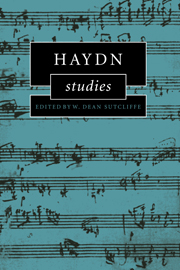Book contents
- Frontmatter
- Contents
- Preface
- Editor's note
- 1 The consequences of presumed innocence: the nineteenth-century reception of Joseph Haydn
- 2 Haydn's sacred vocal music and the aesthetics of salvation
- 3 Sentiment and sensibility in La vera costanza
- 4 Haydn as Romantic: a chemical experiment with instrumental music
- 5 Haydn's ‘Cours complet de la composition’ and the Sturm und Drang
- 6 Haydn's reversals: style change, gesture and the implication-realization model
- 7 Haydn's symphonies between Sturm und Drang and ‘Classical style’: art and entertainment
- 8 The Haydn piano trio: textual facts and textural principles
- 9 Papa Doc's recap caper: Haydn and temporal dyslexia
- 10 Haydn: the musicians' musician
- Index
9 - Papa Doc's recap caper: Haydn and temporal dyslexia
Published online by Cambridge University Press: 22 September 2009
- Frontmatter
- Contents
- Preface
- Editor's note
- 1 The consequences of presumed innocence: the nineteenth-century reception of Joseph Haydn
- 2 Haydn's sacred vocal music and the aesthetics of salvation
- 3 Sentiment and sensibility in La vera costanza
- 4 Haydn as Romantic: a chemical experiment with instrumental music
- 5 Haydn's ‘Cours complet de la composition’ and the Sturm und Drang
- 6 Haydn's reversals: style change, gesture and the implication-realization model
- 7 Haydn's symphonies between Sturm und Drang and ‘Classical style’: art and entertainment
- 8 The Haydn piano trio: textual facts and textural principles
- 9 Papa Doc's recap caper: Haydn and temporal dyslexia
- 10 Haydn: the musicians' musician
- Index
Summary
Discussions of sonata form, and especially analyses of movements in sonata form, routinely pay less attention to recapitulations than to expositions or developments, probably because of an assumption that a section whose main purpose is resolution should raise few new problems of its own. Such an assumption is not always unjustified: sparks might not often fly in a discussion of Schubert's (or even many of Mozart's) recapitulations.
But if some composers take a vacation during the recapitulation, Haydn is not among them. His recapitulations often involve the complete recomposition of their respective expositions, causing Tovey repeatedly – and misleadingly – to remark that they resembled Beethoven's biggest codas. The means by which Haydn transforms the exposition into something completely new in the recapitulation (prefix, suffix, expansion, contraction, parenthetical insertion, reinterpretation of function, ellipsis, splice, overlap, elision) are the same ones he uses to turn simple sentences or periods into more complex or asymmetrical local groups. In addition to putting the material of the exposition through a kaleidoscope, Haydn usually changes the position and harmonic orientation of its main cadences: he is equally inventive with respect to phrase design, harmonic structure, and to the relationship between the two.
Haydn's extreme wildness can provoke an unseemly haste to demonstrate the hidden lawfulness of his most delicious misdeeds. Just as performances often smooth over Haydn's rough edges, we run the risk of a attributing his compositional decisions to thought-processes as pedestrian as those of the analyst.
- Type
- Chapter
- Information
- Haydn Studies , pp. 291 - 320Publisher: Cambridge University PressPrint publication year: 1998
- 2
- Cited by

